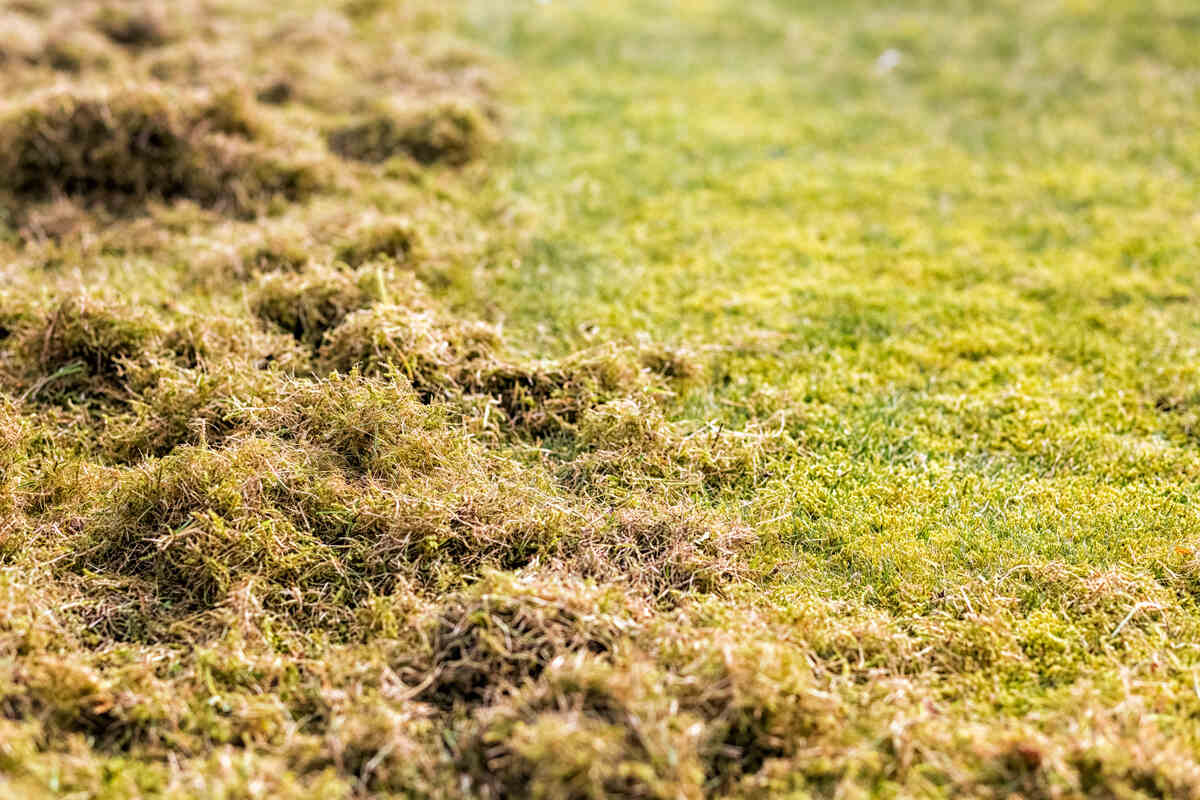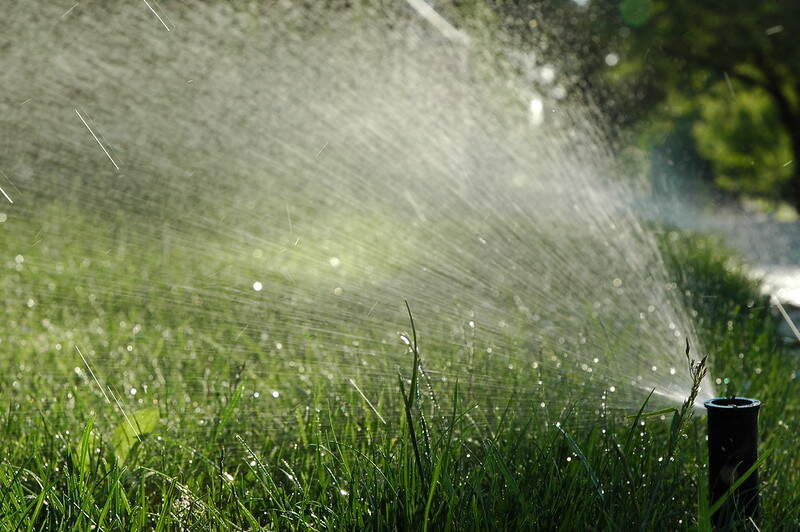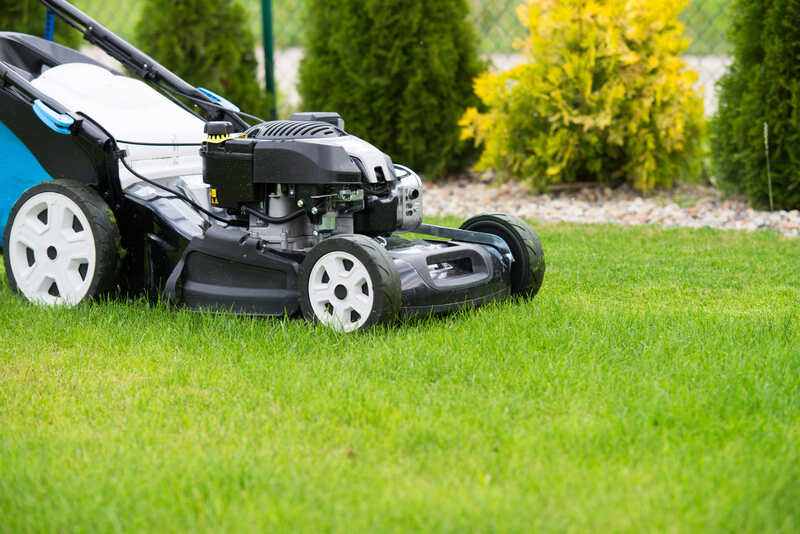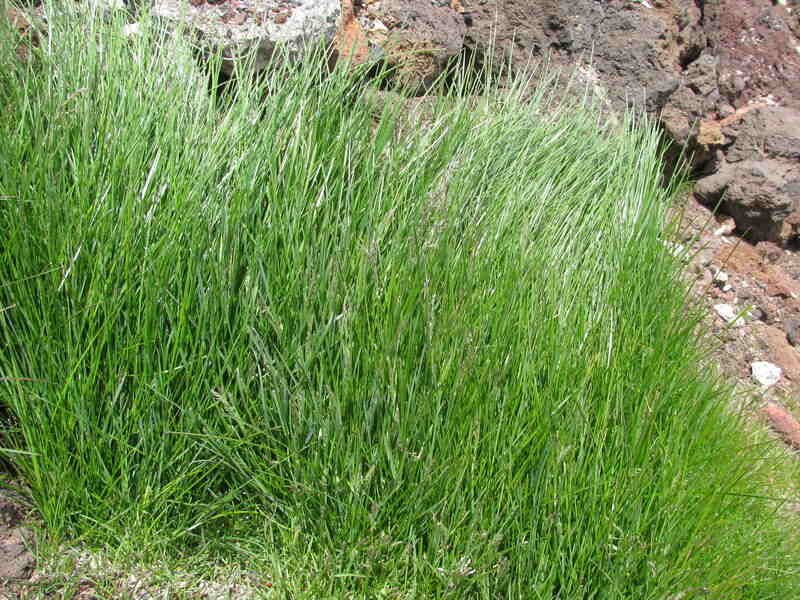
The best way to prevent thatch in your lawn is to reduce chemical pesticides and avoid applying too much nitrogen. But that’s not all.
You need a good mowing and watering schedule and must keep the soil loose and rich in organic matter. To help you reduce thatch buildup in your lawn, I spoke with Dr. Wendell Joseph Hutchens, Assistant Professor of Turfgrass Science at the University of Arkansas, who shared valuable information about the role of fertilizers and soil pH in controlling thatch.
Keep an Eye on the Thatch

If the lawn starts feeling a bit elastic and spongy, like walking on thick carpet, it might be the beginning of a thatch problem.
What is Thatch?
The thatch in your lawn is a dense mat of roots, runners, and stems mixed with dirt. It forms between the soil surface and the grass.
What does thatch look like? Thatch resembles a chocolate-brown sponge or peat moss. It has a fibrous, elastic texture and compresses easily when squeezed.
Is Thatch Good or Bad?
Thin thatch, under 1/2 inch, protects the roots from extreme temperatures and preserves soil moisture. However, when it is over 1/2-inch thick, it blocks airflow, water, and nutrients from reaching the roots. This leads to weaker, thinner grass that is more exposed to pests and diseases.
If the thatch is about 1/2-inch thick, something is supporting it, and you need to take preventive measures. To check the thickness, cut out a 2- to 3-inch piece of turf with a trowel or a grass plugger and measure the thatch layer.
The most common causes of thatch include incorrect lawn care and overfertilization, so preventing it is mostly about adjusting lawn maintenance practices.
Don’t Overuse Fungicides and Insecticides
Insecticides and fungicides kill the microbes and earthworms that decompose the thatch.
Earthworms are especially important. When they burrow through soil, they aerate the thatch and mix in dirt, castings, and microorganisms, combining all the necessary ingredients for thatch decomposition.
When the earthworm population decreases, thatch starts building up.
One study found that the repeated use of pesticides for three years in a row caused a thatch layer of 3/4 inches in Kentucky bluegrass, while untreated areas had no measurable thatch. The areas treated with pesticides had up to 10 times fewer earthworms.
How can you limit pesticides and prevent thick thatch while still keeping a pest-free lawn? Here are four tips to help you:
- Learn more about Integrated Pest Management and rely on cultural practices for pest prevention.
- Identify the pest and use a selective pesticide to target it.
- Ask your local Extension Office about suitable plant-based or biological pesticides.
- If you need to use a synthetic product, look for one labeled as less toxic to earthworms.
Water Deeply and Less Often

Deep, infrequent watering leads to less dead grass material that can turn into thatch.
What do I mean by that? Deep, infrequent watering helps turfgrass develop long roots that grow deep into the soil. In contrast, frequent, light watering leads to short root balls that stay close to the surface.
When roots grow deep into the soil, there’s less root material near the surface where thatch forms. As a bonus, deep-rooted grass plants are also more resilient to stress and shed fewer dead runners and stems — the main thatch ingredients.
Here’s how to use your watering routine to prevent thatch buildup:
- Install a sprinkler system to better control lawn irrigation.
- Water one or two days a week, applying 1 inch of water per week.
- Irrigate in early morning or late afternoon to reduce evaporation and allow the water to get deep into the ground.
- Check your sprinkler system by doing a lawn sprinkler audit once a year and repair or adjust damaged sprinkler heads.
See Related: How Often Should I Water My Lawn?
Aerate Your Soil

Aeration improves airflow and speeds up thatch decomposition.
Core aeration removes plugs from the soil and leaves behind tiny holes that improve airflow and water drainage. It also raises microbe-rich soil, speeding up thatch decomposition.
Dr. Hutchens emphasizes that using aeration or vertical mowing [a type of dethatching] as part of your lawn care routine is “paramount to preventing thatch buildup in a lawn.” He explains, “These cultivation practices remove thatch from the turfgrass system and also provide many other plant health benefits if done at the proper time.”
Here’s how to use aeration to prevent thatch build-up:
- Aerate once or twice a year if your soil is compacted.
- Dethatch your lawn before aerating to improve the aerator’s access to the soil surface.
- Leave the plugs on the lawn and crumble them with a rake. They contain soil microbes that help thatch decompose.
See Related:
Reduce Nitrogen Applications

Limiting fertilizer applications slows down grass growth and reduces the production of roots, rhizomes, stolons, and stems.
Dr. Hutchens notes that excessive lawn care inputs can lead to thatch buildup and compromise grass health. When it comes to fertilizing the lawn, too much is detrimental, he says.
A good rule of thumb is to reduce the amount of nitrogen fertilizer if you apply more than 4 pounds yearly. By how much? Every lawn and grass type is different. Dr. Hutchens explains that “factors such as turfgrass species, weather, traffic, soil type, etc., all influence the amount of nitrogen the plant needs.”
“My best recommendation is to follow local University Extension guidelines for fertilizing turfgrasses.”
You can also prevent thatch build-up by:
- Using slow-release fertilizer that ensures a uniform growth rate.
- Replacing some of the synthetic nitrogen with compost or an organic source of nitrogen such as fish meal, blood meal, feather meal, or sea kelp.
- Growing grass types that are naturally darker green and stay that way without extra nitrogen: for example, the Kentucky bluegrass ‘Midnight,’ ‘Blacksburg,’ or ‘Eclipse’ varieties.
Keep Soil Healthy With Amendments
Thatch-decomposing microbes thrive in slightly acidic (a 6.5 pH is ideal), moist, loose soils rich in organic matter.
According to Dr. Hutchens, if the soil pH is too low, below about 5.5, there is less microbial activity in the soil. As a result, thatch builds up faster because fewer microbes are present to break down the organic matter. Soils with a high pH (too alkaline) can have the same issue.
Lawns grown on sandy soil (low in organic matter) and clay soil (prone to compaction) are also more prone to thatch.
To check if your lawn is healthy and favorable for microbial life, test the soil at least once every two years. You can learn how to use a soil test kit, available online and in garden stores, or you can take a soil sample and send it to the local Extension Office.
There are many types of soil amendments you can use to boost microbial activity and prevent the thatch layer from getting any thicker. Here are the top three:
- Amend the soil with lime if the pH is lower than 6.0.
- Spread compost as lawn topdressing to amend sandy soil and improve its texture.
- Add gypsum or organic matter to improve clay soil and reduce compaction.
Mow Regularly

Infrequent mowing causes long grass clippings. When over 1 inch long, they decompose slower and can add to the thatch.
Generally, leaving grass clippings on the lawn does not lead to thatch. Actually, according to experts at the University of Massachusetts Amherst, this practice encourages a healthy population of microorganisms that break down clippings and thatch.
However, long clippings can get caught in the grass and not reach the soil surface where decomposition occurs. This can happen when you mow infrequently and the grass gets too tall. To avoid thatch build-up:
- Set a regular mowing schedule to mow the grass at the right height and keep the clippings shorter than 1 inch.
- Cut less than 1/3 of the blade length. This reduces the stress on grass plants and produces small grass clippings.
- Use a mulching mower if you keep the grass tall or it’s a type with a rough texture, such as Bermuda or Zoysia.
- If you don’t have access to a mulching mower, bag the clippings and add to your compost, or use the grass clippings as mulch in the garden.
Don’t scalp the grass, either. Short grass has shallow roots that dry out more easily during drought and add to the thatch layer. Also, avoid mowing on soggy soil since mowers can sink into the turf and accidentally scalp the grass.
See Related:
Choose the Right Grass

You can avoid a thatchy lawn by growing turfgrass types that are less prone to thatch.
Grasses that spread horizontally through rhizomes and stolons (Kentucky bluegrass and most warm-season grasses) are more prone to producing thatch. That’s because the turf grows denser, and the rhizomes and stolons have hard tissue that decomposes slower in the soil.
Turfgrass types with a tufted growth, which includes mainly cool-season grasses, rarely need dethatching.
Here’s a list of the most common turfgrass types ordered by their tendency to produce thatch, according to the experts at the Sports Turf Management Association:
- Moderate to heavy thatch: Bermudagrass, Zoysiagrass, creeping bentgrass, Kentucky bluegrass
- Low to moderate thatch: buffalograss, creeping red fescue
- Low or does not produce thatch: tall fescue, perennial ryegrass
Topdress the Lawn
Spreading topdressing across the lawn can help decompose the thatch layer from top to bottom.
Turf experts at the Sports Turf Management Association say that spreading topdressing on turfgrass and mixing it into the thatch helps dilute the organic matter buildup. It also adds microbes that can help break down the thatch from the top.
How to use topdressing as a thatch prevention method:
- Apply in only a thin layer of 1/8- to 1/4-inch thick to avoid covering too much of the grass.
- To prevent layering, select topdressing, garden soil, or compost that matches the texture of your lawn soil. Use a rake to blend it into the top layer.
- Make two to four applications per year.
Keep a Thin Thatch Layer with Professional Lawn Care
Thatch is harder to remove than to prevent. All you need to do to keep it from building up is proper lawn care, and LawnStarter pros can help with that. Get your free quote now and ensure your lawn receives proper mowing, fertilization and aeration so thatch is kept under control.
Read More:
Sources:
- Minner, D.D., Everhart, E. (2009). Thatch Control in the Home Lawn. Iowa State University. https://store.extension.iastate.edu/product/Thatch-Control-in-the-Home-Lawn
- USDA Natural Resources Conservation Service. (2010, October). Soil Quality Indicators. https://www.nrcs.usda.gov/sites/default/files/2022-10/Earthworms.pdf
- Sports Turf Managers Association (n.d). Thatch Management. https://www.stma.org/sites/stma/files/STMA_Bulletins/Thatch_Management.pdf
- University of Massachusets Amherst (2011, May). What is Thatch? https://ag.umass.edu/home-lawn-garden/fact-sheets/what-is-thatch
Main Image Credit: Ingo Bartussek / Adobe Stock